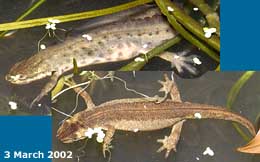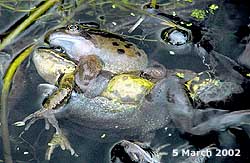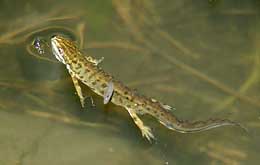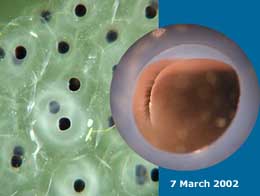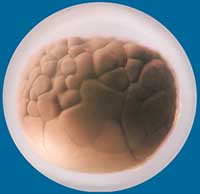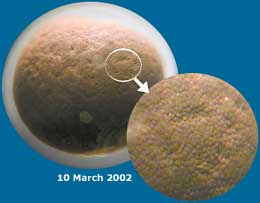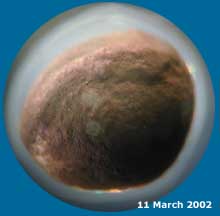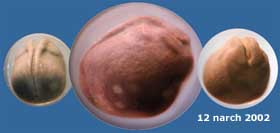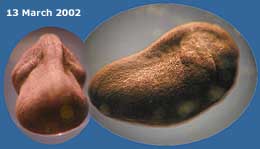Go to last entry.......................................Go to previous entry
Despite this there was a certain amount of splashing as I approached the pond at 8am, and the area covered by spawn has continued to grow overnight. The picture shows the shallow end of the pond. It measures about 5ft (1.5m) across by 4ft (1.2m) and is now covered by an almost continuous layer of spawn.
As the day progressed, so did the orgy of spawning. In this picture (taken at 2.30pm) you can see the feet of the female at the centre of the writhing scrum of males. It's no wonder that they sometimes drown as a result of these encounters. Click on the images for larger versions.
There was not a frog to be seen at 8am, just the ice patterns over all the water surface reflecting the morning light. There was some activity in the day, once the ice melted, but it was on a much lower scale than the last few days.
There is still the surge of hopeful males when something moves, but no sign of scrums today.
While most seem to have moved to the weeds of the open water, some frogs still move about amongst the spawn, and the whole mass seems to wobble when ever one of them tries to move about on it. If you take a close look at the large version of this image you may see that some of the frog embryos have already developed from their original spherical shape.
Some at least seem to be still interested in anything that moves, but there is no longer the enthusiasm of last week. Many are obviously alert to predators as they crash dive whenever I walk near the pond.
The males (top image) are especially wary of torchlight, although this one stayed put long enough for me to capture an image that shows that it has developed its breeding crest. You can see the difference in the hind feet of the male and female newts - it is probably best to click on the picture for a larger version.
Last night at around 10pm I did see two scrums in action around some unfortunate females, and the picture shows one at lunchtime today. It shows a female (with the bulging yellow underside) sandwiched between two males who are clutching her tightly with their front legs, while her legs are outstretched, helplessly. Click on the picture for a larger version.
In contrast, the newts are very busy. It is difficult to count them as they keep on the move and often disappear under the pond plants, but I estimate that I saw between twenty and thirty. There are definitely more than I saw last year. Every so often you can hear a quiet 'plop' and see a bubble left on the surface where one has come to the surface to take a quick breath. The picture shows a male doing just that. The small grey shape seen about half way along its body is a small flatworm that was gliding upside-down along the water surface. Click on the picture for a larger version. At 10.30pm, and with the outside temperature at 11C there are lots of frogs at the surface and a bit of croaking going on!
While the spawn grows, sunshine
and mild temperatures (13.5C at 11am) have encouraged the frogs
to practise their choral croaking again. Quite a few have now
migrated back to the small pond, and are starting to sit out
on the sides. An update at 5.30pm - I have just taken this second image of the embryo pictured above (at 10.15am - seven hours before this one). The difference is amazing. I believe that the embryo has now reached the stage of being known as a Blastula. If I am correct, the smaller cells seen at the top represent the animal hemisphere from which the tadpole will develop, while the larger cells of the lower hemisphere are yolk-containing cells.
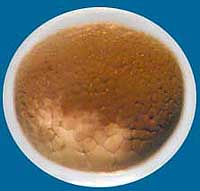
8 March - This image shows the embryo at 8am this morning. You can see how the yolk cells are forming a lighter patch at the bottom of the image. In the pond there is still some croaking going on, but the frogs are nowhere so eager to chase each other today, and I can see no new spawn. 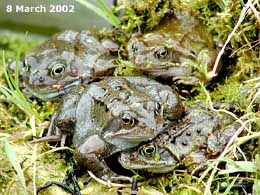
One characteristic sight here through the summer months is tightly packed groupings of frogs on the bank or on a rock in the small pond. I have just spotted this group of four taking advantage of today's good weather - sometimes there are a dozen or more gathered like this, especially on a sunny day. There will not be a diary entry tomorrow.
The insert shows an enlarged bit of the surface , showing it to have a dimpled texture, presumably the outer layer of cells. If you click on the image you can see a larger picture of the embryo, showing this texture.
Outside, on a very windy day (temp 10C), I can only see one frog at 3.30pm. 11 March - The frog embryo is now showing the firsts signs of the development of structure. Look carefully at the top half and you should see raised ridges running upwards in an arc from the left side towards the right. A look at my old biology text-book and its diagrams suggests that these mark the development of the Neural folds. The area between the folds would be the medullary plate, from which the brain and spinal cord will form. The diagram in my book indicates that, if what I have said is correct, the top right of the image represents the front or anterior of this development. If you click on the image you can see a larger picture of the embryo, showing this growth and the dimpled cell texture more clearly. In the pond it has been an active day again with lots of croaking and two new patches of spawn! More and more frogs are now spending time on the banks of the pond.
The left and right folds will gradually fuse together to enclose the Neural tube. In this tube the tadpole's spinal cord and brain will develop. If you click on the image you can see a larger picture of the embryo, showing this growth more clearly.
The left image shows how the Neural folds are now linked up If you click on the image you can see a larger version. |
|
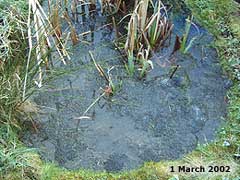
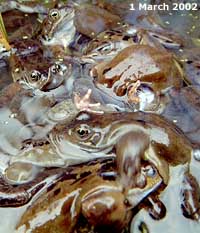
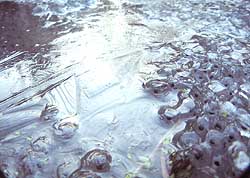 2
March - The spawn met
its first big challenge last night as the air temperature fell
below 0C and the pond and spawn was covered with a thin but continuous
layer of ice.
2
March - The spawn met
its first big challenge last night as the air temperature fell
below 0C and the pond and spawn was covered with a thin but continuous
layer of ice.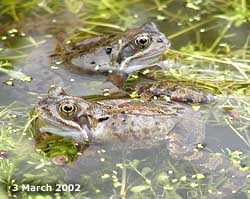 3
March - A milder start
to the day meant lots of frogs in sight again. However, the level
of activity has somewhat diminished now and there seem to be
a lot of frogs waiting around for something to happen. The croaking
continues, but the volume has been turned down.
3
March - A milder start
to the day meant lots of frogs in sight again. However, the level
of activity has somewhat diminished now and there seem to be
a lot of frogs waiting around for something to happen. The croaking
continues, but the volume has been turned down.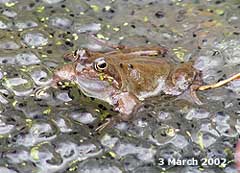
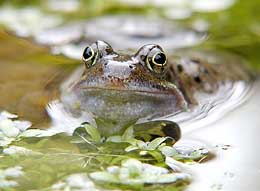 4
March - All over the
pond now are pairs of eyes like these, gazing in all directions.
Are they all waiting for another mate to arrive? Or is it time
to rest after all the exertions of last week?
4
March - All over the
pond now are pairs of eyes like these, gazing in all directions.
Are they all waiting for another mate to arrive? Or is it time
to rest after all the exertions of last week?